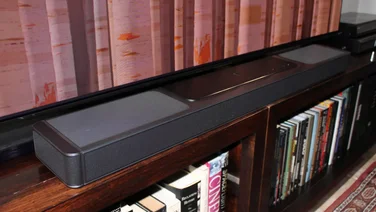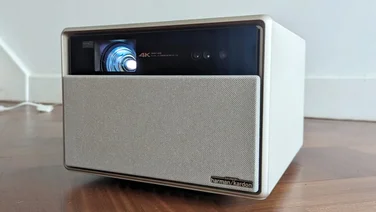To help us provide you with free impartial advice, we may earn a commission if you buy through links on our site. Learn more







- Compact and flexible design
- Good overall picture quality
- Beefed-up sound
- Lacks contrast in dark scenes
- Battery life could be better
- Missing some catch-up TV apps
After last year’s MoGo 3 Pro, the XGIMI MoGo 4 projector might seem a little underwhelming. Where the MoGo 3 Pro ditched the straight vertical box design of the MoGo 2 Pro for a cool transforming cylinder, the MoGo 4 is more of a refinement: a sort of MoGo 3 Pro redux.
It maintains or improves on the MoGo 3 Pro’s best bits, fixes some of its failings and makes the odd smart change to the design. Is that enough to make it one of the best portable projectors, or even the best portable projector? I’ve spent the last week or so with the MoGo 4 finding out.
What do you get for the money?
The XGIMI MoGo 4 is an ingenious portable projector with a 1080p resolution, 450 ISO Lumens of brightness and a price tag of £509. It incorporates Google TV streaming and has a built-in 2x 6W Harman/Kardon speaker system to deliver room-filling Dolby Digital audio.
When not in action as a projector, it can double as a Bluetooth speaker, while a series of magnetic filters can be used to project fun ambient visuals on the wall or ceiling, next time you’re having a party. XGIMI calls the MoGo 4 a “vibes machine” in the belief that young Gen-Zers and the even younger Gen Alphas will use it not just to watch TV and movies, but as part of their everyday lives. The MoGo 4’s easy portability makes that an option.







In terms of the specs, little has changed in terms of the imaging system since the MoGo 3 Pro. The resolution and brightness are the same, and the MoGo 4 has the same 1.2:1 throw ratio, giving you a 100in image from 2.66m or a 60in image from 1.6m. The speakers are slightly more powerful, albeit only by a single watt per channel. Arguably, the most important new feature isn’t anything to do with the audio or visuals, but the addition of a built-in battery. You can now charge the MoGo 4 via USB-C and use it for up to two and a half hours of video playback or up to six hours of music.
Like many compact full HD portable projectors, including Anker’s Nebula Capsule 3, the MoGo 4 uses a 0.23in DMD (Digital Micromirror Device) chip with a native 540p resolution, using pixel shifting techniques to reach 1080p. As with the 4K projectors that use pixel shifting, the technique works well enough that you probably won’t notice any distinction in everyday viewing. Given you can usually see some pixel structure on a native 1080p projector when viewing on a 60in to 120in screen, it’s not worth worrying about.
It’s worth mentioning that XGIMI is releasing a second version, the MoGo 4 Laser, which uses a triple laser light source rather than the MoGo 4’s LEDs. This ups the brightness to 550 ISO Lumens and may be a better option for the more discerning mobile movie viewer.
What does it do well?
The most distinctive thing about the MoGo 4 remains its design. It’s not the only projector where a cylindrical body swivels away from a base to reveal the optical system – and Samsung got there first with the Samsung Freestyle – but it’s a really solid and well-executed version of the concept. The body is mounted on an extending stalk that now allows it to rotate through a full 360 degrees. Want to watch a movie on the ceiling while you’re lying in bed? Go right ahead.
The MoGo 3 Pro had a chunky base section, which the MoGo 4 has reduced to a slimmer, semi-translucent stand. With the old model, switching to Bluetooth speaker mode involved twisting the projector to face downwards in the lower of its two height positions, allowing coloured light from the lens to shine through the gap. With the new model, you can simply close it up again, and a subtle glow will still emit through the bottom. The design isn’t smaller – at 207.6mm tall, it’s slightly larger – but it looks more elegant.







Setup is as easy as ever, particularly if you’re using the Google Home app; I had the projector up and running with Netflix, Amazon Prime Video and Disney+ within twenty minutes of getting it out of the box. All the major streaming apps and most of the catch-up services are supported, and XGIMI’s slimline remote supports Google’s universal voice search across the majority of them.
Meanwhile, XGIMI’s ISA technology continues to do a fantastic job of automatic focus, keystone correction and screen alignment, making it stupidly easy to just point the projector at a surface and get a decent image. You can get a slightly sharper, brighter image by positioning it at the right level and from almost straight on, but the results with the projector on the floor tilted upwards are easily good enough for casual viewing. And if you move or knock the projector? No problem. ISA kicks in and quickly fixes any misalignment.
One criticism I had of the MoGo 3 Pro was its subpar connectivity. You only got the USB-C port used for charging, plus a USB-A and a mini-HDMI port, and the latter meant you had to fork out for an HDMI to mini-HDMI cable if you wanted to connect external sources. The MoGo 4 packs in a standard HDMI input, making it much easier to hook up a Blu-ray player or games console.







When it comes to image quality, the MoGo 4 is roughly on a par with the MoGo 3 Pro. It’s very good when used in a dark room, delivering a crisp picture with vibrant colours, natural tones and graduations and a presentation that’s fairly cinematic, rather than excessively punchy. Even the motion smoothing isn’t obnoxious.
Having watched Mission Impossible: Dead Reckoning, a good chunk of Mission Impossible: Ghost Protocol, some episodes of Mr and Mrs Smith and a wide range of YouTube videos, Netflix and Disney+ shows and miscellaneous test material, I’ve found it a fun and easy watch. Sure, it’s not 4K and HDR effects are more vaguely visible than actually impactful, but it makes most content look good.
As is so often the case with portable projectors, the big issue is brightness. Like the MoGo 3 Pro and the MoGo 2 Pro before it, the MoGo 4 struggles in dark or gloomy scenes, failing to resolve much detail in areas of shadow and suffering from a distinct lack of contrast. In tests, I also couldn’t get near the stated 90% DCI-P3 coverage, reaching a maximum 63.9% with a gamut volume of 78.7%. That’s still pretty good for an affordable portable projector, but some way off a high-quality home cinema model.







Still, if picture quality hasn’t moved on much since last year, sound is a different matter. An extra watt per speaker doesn’t sound like much, but XGIMI has done a little tuning to create a sound that’s slightly warmer, more powerful and better-rounded than the rather harsh and brittle tone the MoGo 3 put out. It’s great for thumping action movie scores and clear and easy to listen to in everyday TV shows and dramas.
It’s also more confident with music, whether you’re watching concert footage or using it as a Bluetooth speaker. The sound can still be slightly boxy at low or very high volumes, and there’s still not much in the way of stereo spread, but – again – it’s fine for casual listening or viewing.







Finally, a quick word about the extras. XGIMI has bundled a nice slimline wand remote, complete with shortcut keys for Amazon Prime Video, Netflix and YouTube and a custom shortcut button to add your own. It has also included a second mini remote, which hooks onto the MoGo 4 with a lanyard-style strap. This has a D-pad with a central select button, volume up and down keys and a back button. It allows you to quickly browse through apps and control playback if the standard remote is not to hand.
It’s not really a must-have, but it is a nice little bonus. And while I won’t spend so much time using the bundled magnetic ‘sunlight’ filter, it’s a lot easier to fit than last year’s attachable ambient projection filters, and could be a fun and atmospheric addition to your next house party.
What could it do better?
If you’re looking for a portable projector you can use during daylight hours, your search goes on. The MoGo 4 still struggles to show anything visible, and is at its best under a dark night sky or – better still – in a properly dark room.







And while the built-in battery is a definite plus, it’s only going to get you through a long movie if you keep the projector in its Eco mode, which results in a noticeable dip in brightness. In Standard mode streaming movies, the battery lasted 1hr 52mins.
As I mentioned earlier, XGIMI’s implementation of Google TV covers most of the major streaming apps, but there’s currently no way to install the Channel 4 app or BBC iPlayer. The MoGo 4 isn’t something you buy to replace your TV, but you’ll miss these platforms if you’re hoping to follow sports or keep up with your favourite shows while away on holiday.
Should you buy the XGIMI MoGo 4?
The MoGo 3 had its drawbacks, but it was still one of the best portable projectors. The MoGo 4 has better sound, a refined design and a built-in battery, alongside the best overall image quality we’ve seen from such a compact model.
The Nebula Capsule 3 is smaller and in some ways more convenient, but the MoGo 4 goes brighter and now beats the Nebula on sound. Meanwhile, the XGIMI Halo+ goes even brighter with superior audio and sound, but is significantly larger, not to mention more expensive. The MoGo 4 isn’t perfect, but it’s great for what it is and how much it costs.







